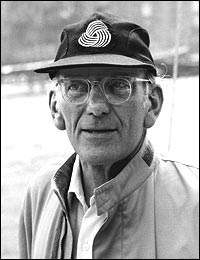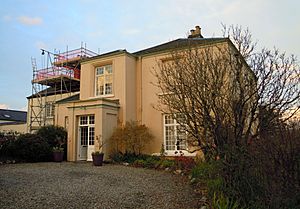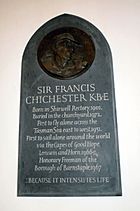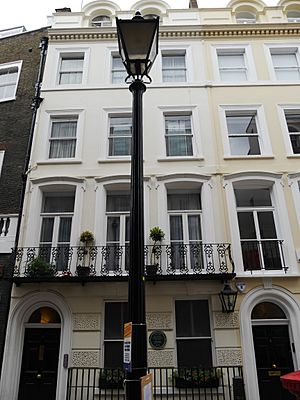Francis Chichester facts for kids

Sir Francis Charles Chichester (born September 17, 1901 – died August 26, 1972) was a brave British adventurer. He was a successful businessman, a skilled pilot, and a famous solo sailor.
Queen Elizabeth II made him a knight. This was because he was the first person to sail alone around the world by the clipper route. He also did it faster than anyone before him. His amazing journey took nine months and one day in 1966–67.
Contents
Biography
Early Life and Business
Francis Chichester was born in a village called Shirwell in Devon, England. His father was a clergyman. When he was six, he went to a boarding school. Later, he attended Marlborough College during World War I.
At 18, Chichester moved to New Zealand. Over ten years, he built a successful business. He worked in forestry, mining, and property. However, he lost a lot of money during the Great Depression.
Pioneering Aviator
In 1929, Chichester returned to England. He learned to fly and became a pilot. He bought a de Havilland Gipsy Moth plane. He planned to fly it all the way to New Zealand. He hoped to break a record for a solo flight to Australia.
He faced mechanical problems, so he didn't break the record. But he still completed the long trip in 41 days! His plane was then sent to New Zealand. He couldn't carry enough fuel to fly directly across the Tasman Sea. So, he added floats to his plane.
Chichester then made the first solo flight across the Tasman Sea. He flew from New Zealand to Australia. He was also the first to land a plane at Norfolk Island and Lord Howe Island. His trip was delayed when his plane was badly damaged at Lord Howe. He had to rebuild it himself with help from the islanders.
Chichester was very clever with navigation. He used a method called "off-course navigation." This helped him find small islands in the vast Pacific Ocean. He used a sextant to measure the sun's position. This was hard to do while flying alone.
He would fly to a certain point. Then, he would turn 90 degrees and fly along that new line. This helped him find his destination even if his earlier calculations were a bit off. This smart technique earned him an award. Chichester then wanted to fly solo around the world. He reached Japan, but he crashed into an overhead cable. He was seriously injured.
World War II and Maps
When World War II started, Chichester wanted to join the Royal Air Force. But he was too old and his eyesight wasn't good enough. He finally joined in 1941. He worked in the navigation section.
He wrote a special navigation manual. This guide helped fighter pilots fly across Europe and back. It taught them how to navigate alone, similar to his own flying methods.
After the war, he stayed in the UK. He bought many old Air Ministry maps. First, he made jigsaw puzzles from them. Later, he started his own successful map-making company.
Becoming a Yachtsmen
In 1958, Chichester faced a serious health issue. Doctors thought it was very bad. But his wife, Sheila, put him on a special diet. Amazingly, his health got much better. After this, Chichester decided to try long-distance yachting.
In 1960, he entered the first Single-Handed Trans-Atlantic Race. He won the race in his 40-foot boat, Gipsy Moth III. Four years later, he came in second place in the same race.
Sailing Around the World
On August 27, 1966, Chichester began his most famous journey. He sailed his boat, Gipsy Moth IV, from Plymouth, UK. He returned there on May 28, 1967. He had sailed around the world in 226 days. He made only one stop, in Sydney, Australia.
He became the first person to sail solo around the world from West to East. He also sailed past the Great capes, which are very dangerous. His goal was to beat the times of the fastest clipper ships from the 1800s. His trip was also the first to have a commercial sponsor. The International Wool Secretariat's Woolmark logo was on his boat and his hat.
Honours and Later Life
In 1961, he received a special medal for his navigation skills. In July 1967, after his amazing solo journey, Chichester was knighted. Queen Elizabeth II used the same sword that Queen Elizabeth I used to knight Francis Drake. Drake was the first Englishman to sail around the world with his crew.
Gipsy Moth IV was later preserved next to the famous Cutty Sark ship in Greenwich. In 1967, a postage stamp was issued in his honour. This was unusual because he was still alive and not a member of the royal family.
In 1968, another sailor, Donald Crowhurst, tried to sail around the world. Crowhurst made up stories about his progress. It was Chichester who realized Crowhurst's reports were not true.
In 1970, Chichester tried another challenge. He wanted to sail 4,000 miles in twenty days in Gipsy Moth V. He missed his goal by just one day.
Sir Francis Chichester passed away from illness on August 26, 1972. He was buried in his family's church in Shirwell, Devon. His wife was later buried with him.
Family
Sir Francis Chichester had two sons, George and Giles. His older son, George, died in 1968. His younger son, Giles Chichester, became a British politician. He was a Member of the European Parliament for many years.
Other Honours
Norfolk Island issued a stamp in 1981. It celebrated Chichester's first aircraft landing there in 1931. Another stamp from Norfolk Island in 1974 showed his seaplane. Australia Post also issued an envelope in 1981 about his Tasman Flight. Great Britain issued another stamp featuring Chichester in 2003. Even Palau and Qatar have issued stamps with his image.
A special plaque honoring Chichester was placed at his family home in London in 1993.





